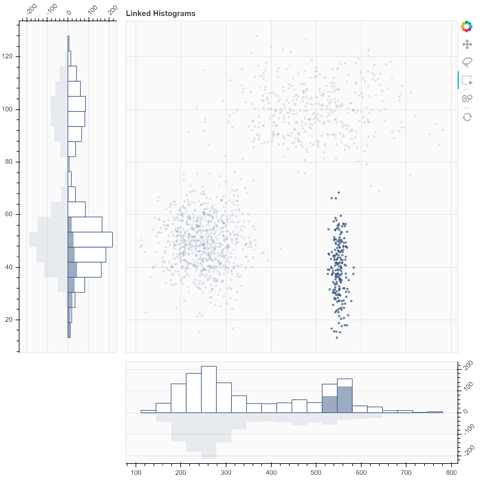That makes sense, thank you! Once I moved the axes to the edges of the grid I got this result.
Putting that together with setting the figure min_border to zero, either using the kwarg or using the attribute directly p.min_border(0), I was able to remove all the space and get it to look how I wanted.
FWIW, here is the final code (which I will be adapting for my actual use case).
''' Present a scatter plot with linked histograms on both axes.
Use the ``bokeh serve`` command to run the example by executing:
bokeh serve selection_histogram.py
at your command prompt. Then navigate to the URL
http://localhost:5006/selection_histogram
in your browser.
'''
import numpy as np
from bokeh.layouts import gridplot
from bokeh.models import BoxSelectTool, LassoSelectTool
from bokeh.plotting import curdoc, figure
# create three normal population samples with different parameters
x1 = np.random.normal(loc=5.0, size=400) * 100
y1 = np.random.normal(loc=10.0, size=400) * 10
x2 = np.random.normal(loc=5.0, size=800) * 50
y2 = np.random.normal(loc=5.0, size=800) * 10
x3 = np.random.normal(loc=55.0, size=200) * 10
y3 = np.random.normal(loc=4.0, size=200) * 10
x = np.concatenate((x1, x2, x3))
y = np.concatenate((y1, y2, y3))
TOOLS = "pan,wheel_zoom,box_select,lasso_select,reset"
# create the scatter plot
p = figure(tools=TOOLS, plot_width=600, plot_height=600, min_border=0,
x_axis_location=None, y_axis_location=None,
title="Linked Histograms")
p.background_fill_color = "#fafafa"
p.select(BoxSelectTool).select_every_mousemove = False
p.select(LassoSelectTool).select_every_mousemove = False
r = p.scatter(x, y, size=3, color="#3A5785", alpha=0.6)
# create the horizontal histogram
hhist, hedges = np.histogram(x, bins=20)
hzeros = np.zeros(len(hedges)-1)
hmax = max(hhist)*1.1
LINE_ARGS = dict(color="#3A5785", line_color=None)
BK_COLOR = "#fafafa"
ph = figure(toolbar_location=None, plot_width=p.plot_width, plot_height=200,
x_range=p.x_range, y_range=(-hmax, hmax), y_axis_location='right',
min_border=0)
ph.background_fill_color = BK_COLOR
ph.quad(bottom=0, left=hedges[:-1], right=hedges[1:], top=hhist, color="white",
line_color="#3A5785")
hh1 = ph.quad(bottom=0, left=hedges[:-1], right=hedges[1:], top=hzeros,
alpha=0.5, **LINE_ARGS)
hh2 = ph.quad(bottom=0, left=hedges[:-1], right=hedges[1:], top=hzeros,
alpha=0.1, **LINE_ARGS)
# create the vertical histogram
vhist, vedges = np.histogram(y, bins=20)
vzeros = np.zeros(len(vedges)-1)
vmax = max(vhist)*1.1
pv = figure(toolbar_location=None, plot_width=200, plot_height=p.plot_height,
x_range=(-vmax, vmax), y_range=p.y_range, x_axis_location='above',
min_border=0)
pv.background_fill_color = BK_COLOR
pv.quad(left=0, bottom=vedges[:-1], top=vedges[1:], right=vhist, color="white",
line_color="#3A5785")
vh1 = pv.quad(left=0, bottom=vedges[:-1], top=vedges[1:], right=vzeros,
alpha=0.5, **LINE_ARGS)
vh2 = pv.quad(left=0, bottom=vedges[:-1], top=vedges[1:], right=vzeros,
alpha=0.1, **LINE_ARGS)
layout = gridplot([[pv, p], [None, ph]], merge_tools=False)
curdoc().add_root(layout)
curdoc().title = "Selection Histogram"
def update(attr, old, new):
inds = new
if len(inds) == 0 or len(inds) == len(x):
hhist1, hhist2 = hzeros, hzeros
vhist1, vhist2 = vzeros, vzeros
else:
neg_inds = np.ones_like(x, dtype=np.bool)
neg_inds[inds] = False
hhist1, _ = np.histogram(x[inds], bins=hedges)
vhist1, _ = np.histogram(y[inds], bins=vedges)
hhist2, _ = np.histogram(x[neg_inds], bins=hedges)
vhist2, _ = np.histogram(y[neg_inds], bins=vedges)
hh1.data_source.data["top"] = hhist1
hh2.data_source.data["top"] = -hhist2
vh1.data_source.data["right"] = vhist1
vh2.data_source.data["right"] = -vhist2
r.data_source.selected.on_change('indices', update)

